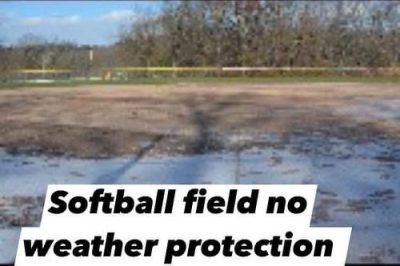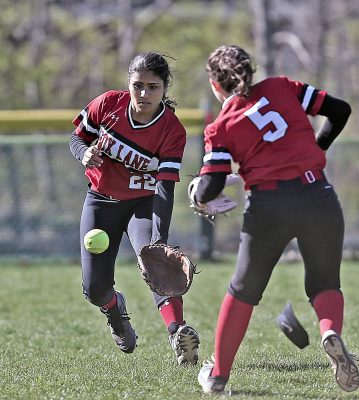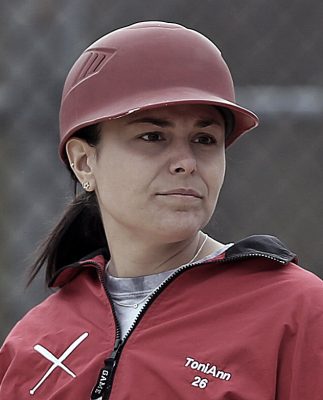50 Years After Landmark Equity Law, Fox Lane Softball Says Fight for Rights Continues
Opinion Advocates for ideas and draws conclusions based on the author/producer’s interpretation of facts and data.
District Emphasizes Program Progress Underway
Half a century ago, when Indiana Senator Birch Bayh helped shepherd Title IX into existence, he noted in a statement the limitations of federal legislation — gender equity written in the law books wouldn’t be enough.
“While the impact of this amendment would be far-reaching,” Bayh concluded on the Senate floor, “it is not a panacea.”
Although Title IX, enacted during the Nixon Administration in 1972, revolutionized the girls’ sports scene in the United States and is widely responsible for the breathtaking advances of the past 50 years, the senator knew the law would only achieve as much as advocates were willing to fight to accomplish.

Even as our early 1970s legislators banned gender-based discrimination in any educational program that gets federal funding with the landmark policy, lawmaking and law enforcement are two very different ballgames.
The remnants of that fight are still playing out in school boards and on ballfields across the country to this day, as activists try to hold districts to account when real-world application of the law falls short of the law’s loftiest ideals. Or even just when inertia sets in over plain-to-see and entirely legal unfairness.
Sometimes the culprit is following the path of least resistance.
The legislation was designed to create a level playing field. Beyond that, laws are just a means to an end, and even when the letter of the law is being followed, the spirit isn’t always. It’s up to people to strive to achieve the ambitious goals that motivated the law in the first place.
In gender equity debates, it’s critical to keep your eye on the ball, or at least on the key question: does the status quo generate a fair outcome for boys and girls?
FOX FIGHT
Here locally, a related movement is growing around Fox Lane girls’ softball in the Bedford Central School District.
“We are petitioning for the immediate improvement to safety and inadequacies of the Fox Lane Softball program and facilities,” Fox Lane softball parents wrote in a Nov. 7 letter to the district.
“The unsafe, inadequate, and unequal conditions of Fox Lane Softball compared to the equivalent Fox Lane Baseball program are unacceptable and unlawful,” the statement continues. “The disparate treatment of our softball athletes evidences an intolerable level of gender bias in our schools.” (If you want a more detailed description of the complaints, beyond what my already too-long column can summarize, read the full letter here.)
Also, don’t be surprised to discover the softball community rallying for its cause at this Wednesday night’s Nov. 30 Board of Education meeting.
“The selected speakers will be addressing the inequities noticed, by our parents and athletes alike, when comparing the FLHS Baseball program and facilities and that of the FLHS Softball program and facilities,” a mass email sent to softball parents on Saturday night stated, also noting that many answers given by the district at an earlier Zoom meeting “still do not adequately meet the requirements of the standard for Title IX.”
“Our players have been frustrated on many issues for a long time, and many of the requests from parents have gone unanswered and unaddressed,” the message continued.
But it’s worth stressing how, at least in my view, Bedford’s powers-that-be appear to be strong supporters of girls’ sports, from the superintendent and athletic director to school board leadership. Yet that doesn’t mean the status quo is at all sufficient or that more focus can’t be directed at the problem.
Efforts to achieve transformative reform, whether gender-related or not, are sometimes battling historical discrepancies more than resistant authorities.
STATE OF THE ENVIRONMENT
Athletic Director Adam Lodewick, for his part, articulated his commitment to equality.

“Making sure all of our teams and programs are treated equally and are provided with the best environment, and the best opportunities for a positive and successful experience has been and always will be my number one priority,” Lodewick told me. “There is an absolute need for the softball field to be upgraded and renovated. I am confident all the current issues will be addressed with the new upcoming bond project and give the coaches and student-athletes a state-of-the-art facility and one they can be proud of.”
At the same time, the central figures of this story are the girls themselves.
“Inequality in girls’ sports isn’t just providing boys with a better field and equipment — it’s providing them with more opportunities to get better as a player, which leads to a better college and a better future,” said Gabriela Naar, a talented Fox Lane High School outfielder who started for the varsity team as a freshman last spring and spoke at a recent Zoom meeting with softball parents, giving voice to various player concerns.
“It’s not only the game you are hurting, but also the opportunities that will impact us in the long run,” remarked Naar, who asked me, entirely unprompted, to be sure I communicate how the current dynamic makes her and her teammates feel like the district does not care about them as much as the boys.
Naar did note how she and many others in the softball community favor a natural surface — a natural surface is featured in a current school district bond upgrade plan — because “turf gets hot and is harder to play on.” (Some softball parents seeking equity are asking for turf, as I elaborate on later).

“I will keep fighting so that future generations of female athletes won’t have to,” Naar said, while also providing unsolicited emphasis on the fact that the upcoming bond helps advance the girls toward the equity they’re seeking.
Before I delve deeper, let me first get a personal piece out of the way.
For a news reporter, if the subjects of a potential story are family, friends, and friendly acquaintances, those subjects are usually the basis of a conflict of interest, and the reporter should usually run in the other direction.
But for a reporting-based opinion columnist like me, if the subjects of a potential story are family, friends, and friendly acquaintances, those subjects are sometimes the basis of providing unique insight into a situation you wouldn’t otherwise possess.
For that reason, I feel (reluctantly) obligated to editorialize on the subject, not despite my tangled web of “conflicts,” but because of them.
My older daughter, now a sophomore, played on the Fox Lane junior varsity softball team last spring, and I’ve been involved to varying degrees over the past seven or eight years with area softball from some “daddy-ball” rec. league coaching to just cheering from the sidelines.
Meanwhile, some of my closest friends in Mt. Kisco constitute the heart and soul of the tireless local baseball community, and The Examiner has supported youth baseball in the area with sponsorships and other promotional initiatives for much of the past 15 years, with plans to do the same for the next 15-plus.
I even interviewed the impressive Coach Matt Hillis myself a few years ago on the occasion of his incredible 300th career win as Fox Lane varsity baseball head coach.
And as tensions start to rise in my hometown, there are lots of stakeholders giving me information and opinions, solicited and otherwise, on the developing debate. The leaders in both communities are all reasonable, thoughtful, intelligent people motivated by a desire to do right by their children and town.
But let me also say this — while the conversation features shades of gray in various ways, there’s one aspect that is black and white: the two programs, baseball and softball, are currently profoundly unequal, and no one can intelligently discount that fact, and basically, no one does. (Although some argue you shouldn’t compare the two at all.)
Bedford Board of Education President Ed Reder participated in a recent Zoom meeting with softball parents. He noted how the board is “delighted to see a newly-engaged softball parent group advocating for their student-athletes, expressing feedback about the softball program.”
“At BCSD, student and parent voices are vital to the partnership with the district in any given program, and in this regard, the BCSD leadership will work collaboratively with the softball parent group and our valued coaches sharing a near and long-term outline of improvements, in existing field conditions, coaching positions, and other items like equipment to increase communication and understanding for the greater benefit of our softball student-athletes,” Reder explained to me in an email exchange preceding a followup phone interview. “While the 2022 bond provided a total renovation to the Fox Lane softball field, which has a planned construction start date in June of 2023, we are also discussing other aspects of supporting the softball program that might be outside field conditions, coaching staff and equipment need to be aimed at addressing equity in funding and student experience.”
Reder’s focus on longer-term, proactive support, over and above the bond, hits all the right notes. Earlier today, Nov. 28, he also sent an email to softball parents, inviting them to a Dec. 6 virtual meeting “to walkthrough the design plans for the new softball field at Fox Lane led by our district field architects.”
GROWING PAINS
My impression is that boys playing Fox Lane baseball correctly feel like they’re part of an elite program with ample institutional and grassroots support. They’re right. Generally and historically speaking, girls playing Fox Lane softball seem to feel like they’re treated unequally. They’re not wrong.
It’s important to stress how local parents shouldn’t be pitted against one another. Plenty of baseball parents are also softball parents and vice versa. Parents are just advocating for their kids, as they should.
The responsibility is with the district to create a fair playing field. But even that assertion could give the wrong impression.
Suppose a current bond moves forward as planned. In that case, the district will deliver softball a profound field upgrade — bullpen/batting tunnels, bleachers, fencing, dugouts, regulation dimensions on a grass and clay field, etc. But some softball parents understandably argue the good of the bond isn’t good enough. (Click here for details on the bond referendum update from Oct. 12).
Simmering tensions bubbled over to social media last week as Fox Lane softball parents began posting pictures illustrating the embarrassingly shabby conditions of the far-off current softball field, tucked away behind the middle school, in contrast to the prominent, tarp-protected baseball diamond at the high school. It’s hard to preach quiet, private patience (or even dispassionate activism) to folks advocating for an overdue public cause.
Comments also noted objections to the upcoming bond, claiming unfair spending with the baseball versus softball enhancements while raising eyebrows over future plans. (The fact that amenities like the baseball tarp among many other training tools are funded by booster donations, not taxpayer-financed district money, is an issue I’ll get to in a minute.)
BONDING TIME
While the district contends the bond, by next school year, will address many of the very issues the parents are complaining about, some softball parents say the spending plan comes up short.
A contingent of parents argues the district shouldn’t upgrade the current (hidden-away) dirt field but instead relocate softball to prime multi-purpose real estate on the main campus and develop a state-of-the-art field there, where other students can spill out of school to possibly watch games, not to mention all the benefits that come with proximity — the girls currently have to lug their equipment from the high school to the middle school after the bell rings.
This contingent of softball parents also says the new surface should be turf (which is more expensive) to aid maintenance and limit cancellations related to field conditions. (Although turf isn’t the choice of many softball purists, past failures to deliver sufficient maintenance at the current field gives turf advocates plenty of ammunition to support their easier-to-manage preference.)
When pushed on logistical complications, whether related to wetlands or other sports already playing on the limited area of school property at the main campus, the parents say it’s the district’s responsibility to figure out those particulars.
They say the beginning of the conversation starts with ensuring fairness, and the policymakers have to work backward from that solemn commitment.
That’s your job, not mine — figure out the details, the group proclaims. (That being said, the parents tell me they have measured specific field options at the main campus and insist a few appropriate alternatives are doable: for instance, in the back of the baseball field, if it’s moved up, they say, or at one of the upper fields.)
MILITARY PRECISION
Fox Lane baseball has flourished thanks largely to Hillis being a no-nonsense leader with a sterling resume, including experience helping coach Army college baseball at West Point.
He is aided by a passionate group of dedicated parents, both current and alumni, who supported the coach’s creation and nurturing of the program over the past two decades.
Among recent giant feathers in Hillis’s illustrious baseball cap was the selection of a former Fox, Henry Davis, as the number 1 overall pick by the Pittsburgh Pirates in last year’s Major League Baseball draft. The star alum made news in March when he donated spikes to the Fox Lane boys, a not irrelevant tidbit in the context of this conversation.
Hillis has always admirably sought to build a college-style, premier program at the high school after being hired by prior leadership at the district in 2002. No serious softball equivalent appeared to be part of any district-developed roadmap at the time. In the current millennium, that apparent cartographic failure of imagination (no fault of Hillis) 20 years ago seems to be chapter one of this story of historical discrepancy and fostered a generation of elite program-development lost.
While Hillis demanded support and excellence since day one in every nook and cranny of the program, many sources say softball seemed to be animated by a “we’re good to go” mentality.
People could argue whether facets of the history are a byproduct of soft gender bias or, more benign neglect, unrelated to gender. But it would be naive, in 2022, to entirely ignore the broader context around developing attitudes of the past 20 years. A discrepancy that might have been unconsciously accepted in the early 2000s is likely more jarring to observe in the world of the last five or so years.
Given the fact that a rising tide lifts all boats, it’s easy to envision a different scenario, where the past two decades could have featured the development of elite baseball and elite softball programs if the proactive motivation was present in or around 2002 and on forward.
(Softball-advocating admirers of Hillis are also quick to point out how they simultaneously and enthusiastically support talented second-year Varsity Softball Coach ToniAnn Licata and believe the young coach has the potential to lead the program to a bigger and brighter future in the shadow of the alleged past neglect. Lodewick, who only started as Bedford’s athletic director in 2019, wants a full-fledged softball program, supporters emphasize, with some of his desired progress more than understandably interrupted since 2020 due to the pandemic and suspended play.)

Developing a cohesive program between KLBS youth softball, the middle school modified team, JV and Varsity, is the signature rallying cry, and progress does take time. (Meanwhile, the growth and improvement in recent years of the local KLBS youth softball program under spirited volunteer leadership have played a significant role in energizing the grassroots movement underpinning the advocacy unfolding in this story.)
“I’m more than willing to sit down with anyone who wants to have those conversations and talk about how we started and how we intended to build, and I always use the word ‘program, program, program,’ and we’ll take it from there,” Hillis told me in a sprawling phone interview on Friday, as he also voiced a general creative eagerness to play a constructive role, wherever possible.
(It also seems relevant to point out how incredibly difficult it is for school districts to hire premier coaching talent — the decorated Fox Lane baseball coach, for example, earns only $6,448 for his time — after spilling blood, sweat, and tears. That total probably translates into something in the range of five cents per hour for Hillis’s all-consuming passion project. The softball job pays the same unfortunate amount.)
It makes sense for Licata to focus on coaching and avoid politics. I did want to reach out as a courtesy. More than understandably, I did not hear back by press time.
BOOSTING BASEBALL
A longtime and vibrant baseball booster club (funded through donations and no district money) pays for baseball amenities and assistant coaching support. In contrast, parents pay out of their own pockets for uniforms. On the girls’ side, a new softball booster club was only started by parents about a year ago. (There’s also a general Fox Lane boosters club that supports all sports.)
But that’s where some of the debate gets tricky. Baseball parents more than understandably want to support, well, baseball. And they’ve done a phenomenal job of augmenting support of their program in a way softball should aim to duplicate.
At the same time, and without any but, questions emerge over how to deliver enduring equity when the starting point is one program with a historical advantage in numbers, infrastructure, and popularity, and another that is badly bruised by the alleged negligence of past leadership, despite recent reforms.
Reasonable people can certainly disagree on the proper remedy. As a result, I did feel like unpacking all the elements of this story was an “ask the experts” situation. While I didn’t receive callbacks by press time from various topic authorities, one of the attorneys I contacted, Laura Pedersen of Renning, Lewis & Lacy, has written about the booster club piece of the puzzle.
“To ensure compliance with Title IX, school districts should examine whether they are providing equivalent benefits and services in their athletic programs for both sexes,” the Oshkosh, Wi.-based attorney explains in an article on her law firm’s website. “When school districts receive donation offers from booster clubs or other support organizations earmarked for the team(s) of one sex, the districts should carefully balance whether they can tend to the donor’s specifications while providing equivalent benefits and services to the team(s) of the other sex. If school districts cannot ensure that balance, they should reject the offered donations.”
Some parents are also eager to stress how helpful a role the Fox Lane Sports Booster Club has played in supporting all teams. (Click here to read some of the group’s achievements).
A scoreboard for softball is just one example.
Baseball dad Ken Diorio, a Bedford Corners resident, emphasized how he could only speak for himself. But he wanted to be sure people understood how the baseball field will be shared by five sports.
“I’m looking forward to a new facility that will serve more of a purpose than a three-month baseball spring season,” he said. “It will open up year-round and especially in the fall when team sports can utilize the all-purpose field for field hockey, football, lacrosse and soccer. Often the main turf field is stacked up with many teams waiting for a small window of practice time going to as late at 10 p.m. on school nights.”

KISSING COUSINS
One thing everyone should adamantly avoid is punishing Fox Lane baseball’s incredible success, earned on the merits. Baseball supporters might reasonably suggest that softball supporters embrace their strategic fundraising tactics — that’s the low-hanging fruit. In fact, there’s certainly more that Fox Lane’s softball community can achieve to follow a best practices path carved by their baseball program cousins.
At the same time, it isn’t just up to the parents (or reporting-based opinion columnists) to craft proposed solutions to any lingering equity issues. The district needs to redouble efforts and continue to acknowledge the problem while also continuing its commitment (pre- and post-bond) to reform through any fair means that ensures baseball doesn’t lose as softball gains. It’s also true that progress has already undoubtedly begun, with Lodewick’s empowerment of Licata in particular, even as there’s more work to be done.
While softball did have a voice on an advisory group formed to develop the bond, a growing and loudening chorus is saying the process neglected to solicit sufficient softball feedback and resulted in a flawed solution to the problem.
To my (non-expert) eyes, and to use a topic-appropriate analogy, the current bond and broader vision appears to be, say, an impressive standup double — maybe even a hustle triple — for softball. In contrast, the current girls and future generations need a grand slam of investment and future planning to make up for past failures by prior leaders.
There’s no reason to assume that creating an elite Fox Lane softball program means cutting into baseball’s prominence and success. In a more cooperative world, community leaders from the two sports would forge an informal alliance and work in tandem, at least in some way, shape, or form.
I happen to know baseball is eager to lend that support. And while a joint baseball/softball booster club might create more problems than it would solve, is it too pollyanna to wonder if there could even be an annual event where the two programs work together to support each other and start stitching together a mutually beneficial relationship? Maybe not that precisely. But something.
The parents fighting for softball equity understand it’s not comparing apples to apples in contrasting proposed baseball/multi-purpose field bond spending (with an emphasis on the fact that multi-purpose field means multiple sports are being played there) and softball bond spending due to distinct cost factors.
And while the approximately $3.7 million cited for the baseball/multi-purpose/multi-sport field upgrades and the roughly $880,000 cited for softball in a presentation might create bad optics, any potentially unfair discrepancies aren’t everyone’s central source of concern. (Click here for a related softball parent presentation on the contrasts.)
Instead, some softball parents say they are most upset about differences around future planning.
BACK TO THE FUTURE
The district seems to be eyeing the possibility of further facility upgrades at the main campus baseball/multi-purpose field in the future, apparently without equivalent, clearly-stated softball plans. The lack of that conversation rankles some parents.
Future plans detailed in architectural drawings for LED lighting, a separate practice infield, and a training facility at the main campus, among other upgrades, sound fantastic. And those and other upgrades will hopefully come to fruition in the years to come to benefit baseball and other main campus field sports.
But it’s not just that softball might eventually fail to receive the equivalent. It’s also the very existence of a future vision for the baseball/multi-sport field, without the same apparent vision and dialogue for softball, that some parents absorb as salt on the wound.
The bottom line is this: while there are plenty of legitimate and non-nefarious causes for inequity, those bureaucratic explanations are likely just meaningless abstractions to most of the young women.
Softball parents and their daughters can help fill some of the fundraising gaps, but a rotating, ever-changing group of parents can’t be expected to reform the long-term culture on their own. Thankfully, parents now seem to have current partners at the district level. Regardless of the private booster funding, the female players look out at the Fox Lane baseball diamond to see male players with better amenities and a program fortified by generations of community support.
Bolstered leadership from the district might include modest measures around the edges, like continuing to encourage the development of a cohesive program, not just siloed teams, with increased communication to the softball community on future blueprints. Some of that dialogue is seemingly underway.
Forging that community and culture will, by osmosis, create more positive energy in the program and lead directly and indirectly to more engaged parents and players stepping up further in extracurricular activities like fundraising initiatives.
Similarly, Hillis instills character education by having his boys help tend to some field maintenance issues where needed. That’s another area in the culture-building department where softball could consider taking cues from baseball.
After all, the ultimate objective of a public school athletic program is to help instill a work ethic and mold future leaders. The energy to push for an elite girls’ softball program is fueled by a desire to reach that end goal.
Also, when any positions open up in the future, as tough as it is to attract top talent with limited public resources, it’ll be critical to again seek out personnel with a passion for softball and long-term program development.
As in all enterprises, public and private, prudent hiring, as well as a clear vision at the top, sets the tone for success or failure.
LATE INNINGS
While it might be fair to ask why softball parents didn’t rally the squad early in the bond process, the focus at this stage of the game needs to be on what’s the ideal investment for generations to come, not just what’s expedient in the 9th inning.
It’s also essential for softball parents to acknowledge how some of the conversation is about logistics and honest differences of opinion over subjective field preferences like turf versus dirt. It isn’t inherently inconsistent to be for gender equity and keeping the unfortunate field location unchanged after weighing all the pros and cons.
There’s a deep well of opportunity for positive change regardless. But the district needs to listen closely to the compelling arguments many parents now present for achieving long-term fairness via field relocation and a pivot to turf. (Even while relocation advocates should prepare for the possibility of bad news from independent architects, depending on what an honest examination reveals about field alternative options.)
It won’t be enough for the district to point to coaching enhancements, the upcoming bond, and the burgeoning parent-led activism. There’s trust to rebuild.
From a public relations standpoint, if nothing else, the district would continue to benefit from an ongoing acknowledgment of past shortcomings while citing those lessons learned as a guidepost for future decision-making.
(Another added wrinkle that complicates delivering equity between the two cousins — baseball and softball — in a way other sports don’t have to confront, is the fact that the field size is different between the two sports. That’s a challenge with baseball versus softball equity planning that districts have to grapple with in a way they do not with sports like basketball, tennis, soccer, lacrosse, and so forth).
“Title IX inequities are most commonly associated with softball on a state and national level because it’s the only sport where they don’t use the same size field as their male counterpart sport — baseball,” a softball parent wrote me after the original version of this article was published.
GAME PLAN
Even with all of that in mind, school districts trying to play equity catch up need to detail a game plan, make public commitments, communicate updates, and keep those promises. That is how to earn meaningful, enduring trust over several years.
And the good news is that current district leadership appears to strongly desire progress, too, even if there’s honest debate over how best to get from Point A to Point B.
Figure out the details and deliver these girls proactive, ongoing, unsolicited, institutional help like never before.
Fifty years out on Title IX, building that systematic support is critical.
“We are confident that bringing this to your attention will finally give our girls a chance at a level playing field and our coaches the support they need to build our program fairly,” the softball parents concluded in their letter earlier this month.
Some progress has been achieved, with more in the current forecast.

Adam has worked in the local news industry for the past two decades in Westchester County and the broader Hudson Valley. Read more from Adam’s author bio here.
